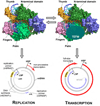Mitochondrial biology. Replication-transcription switch in human mitochondria
- PMID: 25635099
- PMCID: PMC4677687
- DOI: 10.1126/science.aaa0986
Mitochondrial biology. Replication-transcription switch in human mitochondria
Abstract
Coordinated replication and expression of the mitochondrial genome is critical for metabolically active cells during various stages of development. However, it is not known whether replication and transcription can occur simultaneously without interfering with each other and whether mitochondrial DNA copy number can be regulated by the transcription machinery. We found that interaction of human transcription elongation factor TEFM with mitochondrial RNA polymerase and nascent transcript prevents the generation of replication primers and increases transcription processivity and thereby serves as a molecular switch between replication and transcription, which appear to be mutually exclusive processes in mitochondria. TEFM may allow mitochondria to increase transcription rates and, as a consequence, respiration and adenosine triphosphate production without the need to replicate mitochondrial DNA, as has been observed during spermatogenesis and the early stages of embryogenesis.
Copyright © 2015, American Association for the Advancement of Science.
Figures




Comment in
-
Transcription: a mitochondrial switch between transcription and replication.Nat Rev Mol Cell Biol. 2015 Mar;16(3):128. doi: 10.1038/nrm3955. Epub 2015 Feb 18. Nat Rev Mol Cell Biol. 2015. PMID: 25693125 No abstract available.
References
-
- Falkenberg M, Larsson NG, Gustafsson CM. DNA replication and transcription in mammalian mitochondria. Annu Rev Biochem. 2007;76:679–699. - PubMed
-
- Bonawitz ND, Clayton DA, Shadel GS. Initiation and beyond: multiple functions of the human mitochondrial transcription machinery. Molecular cell. 2006;24:813–825. - PubMed
-
- Hallberg BM, Larsson NG. Making Proteins in the Powerhouse. Cell Metab. 2014;20:226–240. - PubMed
Publication types
MeSH terms
Substances
Grants and funding
LinkOut - more resources
Full Text Sources
Other Literature Sources
Molecular Biology Databases

